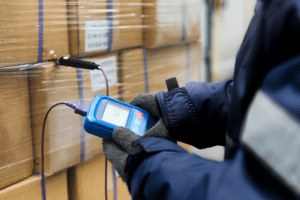Tips for Managing Temperature-Sensitive Goods During Shipping

Even if the temperature is fine at the loading and unloading point, a lot can happen in between. Depending on the route the truck travels, you may see significant variations in outside temperatures. Trips through desert climates can cause temperatures to rise quickly and items to thaw. Mountainous regions, or shipping during the winter, can cause items to freeze.
Overcoming Temperature Variations in Shipping
Shippers typically overcome temperature issues by using reefer trucks that have built-in technology to maintain specific temperature ranges within the truck. Refrigerated LTL trucks often include real-time monitoring and tracking, so operators can monitor internal temperatures and make adjustments if the temperature rises or lowers beyond acceptable measures.
However, many shippers want an independent assessment of temperatures beyond relying on the driver’s word that the temperature stayed within acceptable ranges. Shippers overcome this by attaching a temperature indicator to the freight so that they can be alerted to exposure to unacceptable temperature conditions at any time during transit.
These inexpensive monitors can be attached to freight or inside packing to indicate whether any temperature variation was brief, moderate, or prolonged.
Managing Containers
Making sure you have the right type of container for your goods will make a significant difference.
- Wood is used most commonly for freight that is not impacted by force, such as poultry, seafood, and other meats. Wooden boxes can accommodate dry ice while allowing pressure to escape the packaging. Dry ice can rupture if pressure is not released.
- Plastic boxes are good at eliminating moisture from penetrating the container and are stackable. Plastic works well for produce.
- Cardboard can be used in some circumstances. More affordable and easy to stack, items needing temperature control are often sealed or wrapped and refrigerant gel packs are used to maintain temps. For this, many merchants often seek the help of international freight forwarders. It fastens up the process making it easier for you to settle for a reliable deal. If you wish to seek more details about it, feel free to click here and know about it all.
- Styrofoam boxes act as an insulator to help maintain temperatures as well.
Using the Right Insulation
Inside your container, it’s also important to use the right kind of insulation to keep your temperatures at the right level. If you’re not using Styrofoam or a container that comes with a built-in liner, you will typically want to find a thermal liner, filler, or pad to put inside the container.
Once you have insulation in place, you may also need to add additional filler, such as bubble wrap or packing peanuts to prevent movement and keep your shipment secure while in transit to reduce potential damage.
Protect From Freeze Services
Some temperature-controlled shipments need additional protection to avoid freezing. Commodities, including chemicals, paint, glue, wine and alcohol, liquids, and some perishable foods need to be transported above freezing temperatures.
Most LTL carriers offer Protect from Freeze services, which include sheltering or segregating freight from outside temperatures and employing heated trailers or shelters to keep cargo from freezing.
Other products need to be kept frozen, within tight tolerances. Managing what logistics companies call the “cold chain” can be just as challenging as keeping items from freezing.
Loading and Unloading
Another area shippers run into trouble with maintaining temperatures is during the loading and unloading of goods. For example, temperatures might have been maintained during transit, but the long wait at the freight dock with the doors open can quickly compromise temperatures during unloading.
Drivers should keep trucks parked and the door closed until the loading dock is open and freight can be unpacked immediately. The same goes for loading. While stored in refrigerated containers in the warehouse, if items are sitting in the sun on the loading dock or in an open truck for too long, temps can rise quickly.
This is another reason many shippers have started using their temperature indicators. The built-in systems in the truck would show everything was fine during the transportation phase, but nobody is monitoring the temperatures specifically during the loading and unloading process.
Importance of Monitoring Temperatures
Besides wanting to protect the integrity of your goods and make sure they do not spoil during transit, maintaining temperatures may be important for regulatory compliance and to avoid recalls.
Essentia Health is the subject of a class-action suit after 50,000 patients received vaccinations that may have lost effectiveness due to improper storage temperatures. Having proof of temperature control throughout the entire shipping and storage process from start to finish could be vital information in case of legal action.











Leave a Reply
Want to join the discussion?Feel free to contribute!